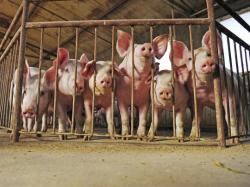New NAHMS Survey To Measure Antibiotic Use, Stewardship
April 28, 2017 | 3 min to read

DES MOINES – Starting in May, the USDA’s National Animal Health Monitoring System (NAHMS) will ask pig farmers who have at least 1,000 pigs and farm in any of the top 13 pork-producing states about their on-farm antimicrobial use and their related stewardship practices. Those states include Colorado, Illinois, Indiana, Iowa, Kansas, Minnesota, Missouri, Nebraska, North Carolina, Ohio, Oklahoma, Pennsylvania and South Dakota.
Specifically, the NAHMS Antimicrobial Use on U.S. Swine Operations 2017 study will:
- Estimate the percentage of production sites using and the percentage of weaned market pigs receiving specific antimicrobials in feed and/or water by reasons for use.
- Describe antimicrobial-use practices in feed and water on production sites.
- Provide baseline data (historical) on antimicrobial-use practices in place before implementation of FDA policy changes (prior to 2017), which can be used for evaluating trends over time.
- Describe antimicrobial stewardship practices on production sites with weaned market pigs or swine nursery and grower-finisher facilities.
“As an industry, we welcome this latest effort by USDA to get accurate information to the public about how America’s pig farmers actually use antibiotics,” said Jan Archer, National Pork Board president and a pig farmer in Goldsboro, North Carolina. “We’ve been good stewards of antibiotics over the years by working with our veterinarian partners and by following guidelines, such as those in the Pork Quality Assurance® Plus certification program. Also, this survey will provide benchmark data that can help our industry as we continue on our journey of continuous improvement.”
The National Agricultural Statistics Service (NASS) will contact producers in the 13 states who have at least 1,000 pigs to ask for their participation in the study. Later this summer, those who agree to participate will meet with a veterinarian from the USDA Animal Plant Health Inspection Service, who will conduct the survey. Importantly, the NAHMS study will protect participants’ privacy by not revealing names or contact information associated with individual data.
“The industry stands to gain with reliable information and improved transparency to consumers and others about how we use antibiotics on our farms,” Archer said. “There’s too much misinformation out there today, and we see this as a way to provide a more accurate picture of how we are doing the right thing on our farms every day.”
For more information about the NAHMS study, contact: USDA–APHIS–VS–CEAH NRRC Building B, M.S. 2E7 2150 Centre Ave., Fort Collins, CO 80526-8117. Phone: (970) 494-7000 Email: NAHMS@aphis.usda.gov or visit NAHMS at: http://www.nahms.aphis.usda.gov
The National Pork Board has responsibility for Checkoff-funded research, promotion and consumer information projects and for communicating with pork producers and the public. Through a legislative national Pork Checkoff, pork producers invest $0.40 for each $100 value of hogs sold. Importers of pork products contribute a like amount, based on a formula. The Pork Checkoff funds national and state programs in advertising, consumer information, retail and foodservice marketing, export market promotion, production improvement, science and technology, swine health, pork safety and sustainability and environmental management. For information on Checkoff-funded programs, pork producers can call the Pork Checkoff Service Center at (800) 456-7675 or check the Internet at pork.org.
Source: The National Pork Board
